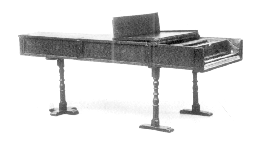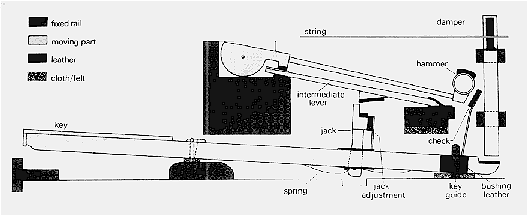The "Why" of the Piano |
|||
by
Dr.
William Leland |
| H | |
ave you ever wondered why the piano was invented? Not when, or how, or by whom, but why? Why would anyone come up with such a contraption? Was there a need for it? Let's take a look at the historical, social, and musical forces which drove the development of the most popular musical instrument in history.
A great invention usually appears not only because someone thinks it up, but also because its time has come - some combination of historical, technological, or social conditions have come together to create a catalyst for the successful realization of an innovative idea. The steam locomotive, for instance, not only played a giant role in the Industrial Revolution, but was first inspired by it: a great leap forward in efficient land transportation was needed and sought after for countless applications. Again, the electric streetcar was born in the 1880's in part because the recent harnessing of electricity converged with both the explosive growth of American cities and a devastating animal disease, called The Great Epizootic, that had slaughtered thousands of horses throughout the Eastern United States during the previous decade.
 Piano by Bartolomeo Cristofori, 1720
Piano by Bartolomeo Cristofori, 1720
So it was with the piano. Conceived and brought into being by a mechanical genius named Bartolomeo Cristofori in Florence, Italy sometime during or before the year 1700, the piano arrived when there was a growing demand for a keyboard instrument that could produce a more authoritative sound than the clavichord, and, at the same time, permit much greater control over dynamic expression than was possible on either the harpsichord or the organ. What gave rise to this demand?
Well, the entire 17th century had seen great advances in all kinds of music: the flowering of opera, oratorio, chamber music and concerto; the firm establishment of tonality and the great enrichment of chromatic harmony and other expressive devices; the spread of concert halls and opera houses; and the development of the symphony orchestra. To be the agents of these great changes, musical instruments themselves had to evolve rapidly; thus, the transverse flute supplanted the recorder, the modern clarinet was developed, and the entire woodwind and brass families were rendered more agile by the invention of new key mechanisms. Moreover, the modern violin, viola, and cello replaced the older viols and entered their period of greatest refinement in the hands of Amati, Guarneri, and Antonio Stradivari and their families.
Keyboard players must have felt left out. They, too, wanted a more expressive and flexible instrument that could meet the challenges of an exciting age. And not only was there a desire among professional players for a more versatile keyboard instrument, but there were also the beginnings of an expanded amateur market for it, as a rising middle class steadily supplanted the old feudal system and more and more people were finding both the means and the time to make music in their own homes.
It appears that a number of individuals experimented with new types of keyboard-to-string arrangements, although very few actual specimens survive. But Cristofori was uniquely qualified. He was already the most renowned harpsichord maker in Florence, and, as such, he had fulfilled numerous contracts for the great Medici family, probably the leading patron of the arts on the entire continent. This gave him access to the Medici museum, a priceless collection of musical instruments of all kinds, and he was in a position to become well acquainted with a great variety of designs both common and experimental. Indeed, Cristofori was later appointed curator of this museum.
Consider then, the fortuitous combination of circumstances that came together as the 17th century drew to a close:
- Freer, more personalized styles of musical expression in all forms
- Rapid and substantial improvements in string and wind instruments
- Social changes resulting in greater participation in music by more people
- The presence of a noted harpsichord maker of great skill and imagination
- The proximity of a valuable instrument collection to which he had access
Now add one final circumstance to the equation:
Sometime around the year 1692, a new and somewhat bizarre instrument was designed by one Pantaleon Hebenstreit, a journeyman musician from Merseburg. It was essentially an outsized dulcimer, upwards of nine feet long, with more than 200 strings and a double soundboard. Its celebrated inventor was soon touring Europe to great acclaim, and his playing was later to so captivate Louis XIV at the Palace of Versailles that the Sun King would decree that henceforth the instrument should be called the Pantaleon. There is no hard evidence that Cristofori ever heard Hebenstreit perform, though one source relates that the latter gave a concert in Florence in 1695, and even suggests that they had a personal meeting. It is well established, however, that the pantaleon was the rage of Europe for a few years, and that it set many keyboard instrument makers to thinking. In any case, we know that Cristofori began experimenting with the notion of a harpsichord with hammers before the end of the decade.

The Cristofori action
The complexity of designing, for the first time in history, a mechanism that, activated by a key lever, could cause a hammer not only to strike a string but rebound instantly, allow the string to keep vibrating even when the finger is held down, stop the sound at will, recover quickly for a new stroke, and permit control of a wide range of dynamics by merely varying the finger pressure, must have been enormous. Yet Cristofori not only solved all of these problems, but even incorporated dual strings for each note, a damper pedal (actually a knee lever), and a shift mechanism that permitted the hammers to strike only one of each pair of strings, exactly like our modern una corda pedal. And by 1726, the date of the latest of his instruments still in existence, his action mechanism had been perfected to the point where it was astonishingly similar to the basic design found today in every Steinway, Bosendorfer, Bechstein, and Yamaha.
So it happened that, at a time when Bach, Handel, and Scarlatti were barely teenagers, a fortunate confluence of conditions and events fired the imagination of a remarkable artisan, who drew on his great skill and imagination to produce the most popular musical instrument in history.
Today, the cultural community faithfully honors the birth and death dates of great names like Beethoven, Mozart, and Chopin, often with elaborate festivities. We pianists and piano teachers should be at pains to celebrate the genius of Bartolomeo Cristofori, to whom we owe--well, just about everything!
Last updated: 02/09/24

